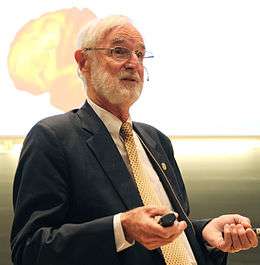Organization for Human Brain Mapping

The Organization for Human Brain Mapping (OHBM) is an organization of scientists with the main aim of organizing an annual meeting ("Annual Meeting of the Organization for Human Brain Mapping").
The organization was established in 1995 at the first conference which was a Paris satellite meeting of the meeting of the International Society for Cerebral Blood Flow and Metabolism (ISCBFM) in Cologne. Although the 1999 meetings of the two societies were coordinated, ISCBFM and OHBM are now completely split.[1] The organizers of the Paris meeting were Bernard Mazoyer, Rüdiger Seitz and Per Roland.[2]
The stated mission of the organization is "to advance the understanding of the anatomical and functional organization of the human brain" by bringing "together scientists of various backgrounds who are engaged in investigations relevant to human brain organization" and engaging "in other activities to facilitate communication among these scientists and promote education in human brain organization."[3] Among the past and present council members of the organizations have been for instance, David Van Essen, Leslie Ungerleider, Albert Gjedde, Richard Frackowiak, Marcus Raichle and Karl Friston.[4]
Since the human brain mapping field is cross-disciplinary the members range from neurologists, psychiatrists and psychologists to physicists, engineers, and statisticians. The OHBM meetings now draws 2500–3000 attendees each year.[5]
Besides organizing meetings the organization has also advocated for data sharing in its field[6] and established a task force on neuroinformatics.[7] This was at a time when Michael Gazzaniga set up the fMRI Data Center, which required researchers to submit scans from functional magnetic resonance imaging when publishing in Journal of Cognitive Neuroscience.[8]
In 2014, the organization established the Glass Brain Award, a lifetime achievement award.[9] Karl Zilles (2014), Marcus E. Raichle (2015) and Robert W. Cox (2016) have been the recipients.[10] The Young Investigator Award (formerly Wiley Young Investigator Award) is also awarded by the organization.[11]
The members of the organization have benefited from reduced rates for the academic journals NeuroImage and Human Brain Mapping.[12] Its administrative office is in Minneapolis.
References
- ↑ Olaf B. Paulson, Iwao Kanno, Martin Reivich and Louis Sokoloff (2012). "History of International Society for Cerebral Blood Flow and Metabolism". Journal of Cerebral Blood Flow & Metabolism. 32: 1099–1106. doi:10.1038/jcbfm.2011.183.
- ↑ "History". Organization for Human Brain Mapping. Retrieved 2015-11-04.
- ↑ "Mission". Organization for Human Brain Mapping. Retrieved 2015-11-04.
- ↑ "Past Officers of OHBM". Organization for Human Brain Mapping. Retrieved 2015-11-04.
- ↑ "Welcome to OHBM 2013". Organization for Human Brain Mapping. Retrieved 2015-11-04.
- ↑ The Governing Council of the Organization for Human Brain Mapping (OHBM) (2001). "Neuroimaging Databases". Science. 292 (5522): 1673–1676. doi:10.1126/science.1061041.
- ↑ "A debate over fMRI data sharing". Nature Neuroscience. 3: 845–846. 2000. doi:10.1038/78728.
- ↑ "Whose scans are they, anyway?". Nature. 406: 443. 2000. doi:10.1038/35020214.
- ↑ ORGANIZATION FOR HUMAN BRAIN MAPPING GLASS BRAIN AWARD
- ↑ ORGANIZATION FOR HUMAN BRAIN MAPPING GLASS BRAIN AWARD
- ↑ OHBM Young Investigator Award
- ↑ "Eligibility & Benefits". Organization for Human Brain Mapping. Retrieved 2015-11-04.